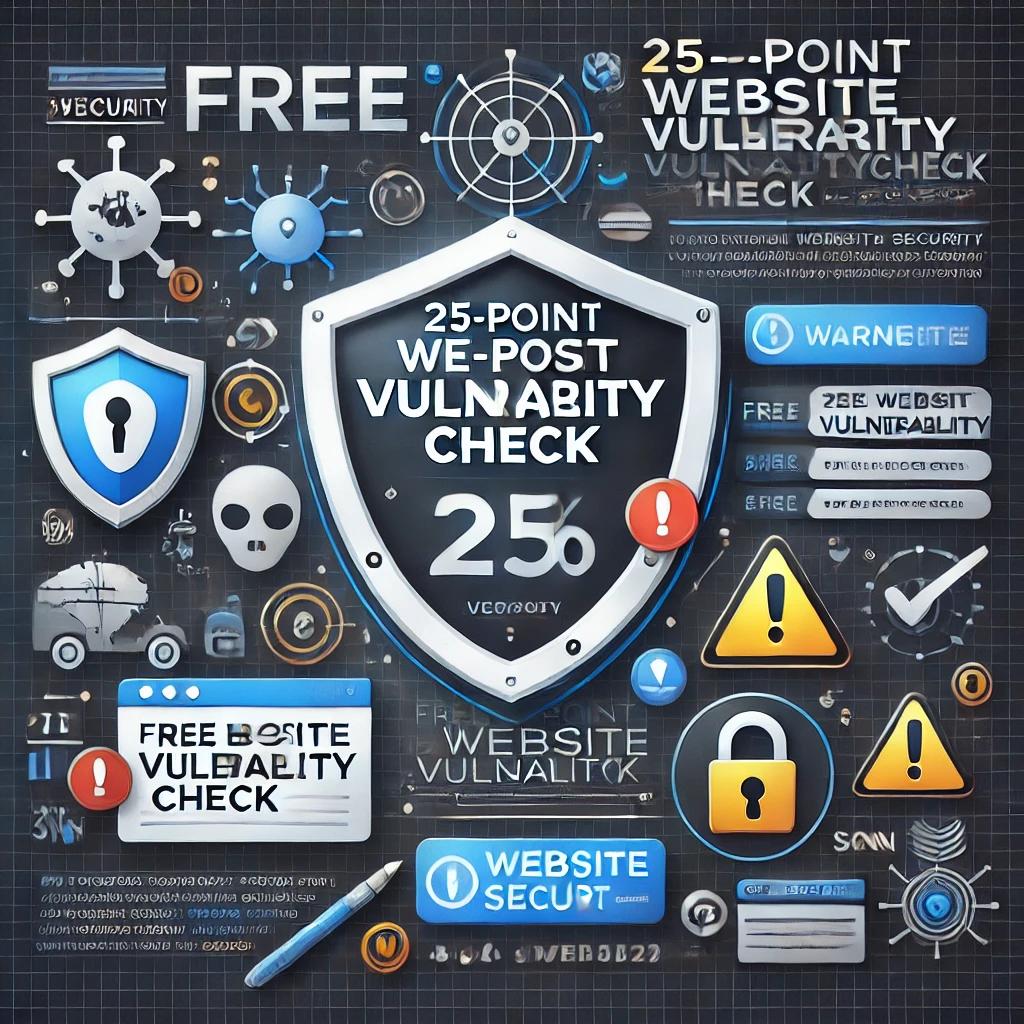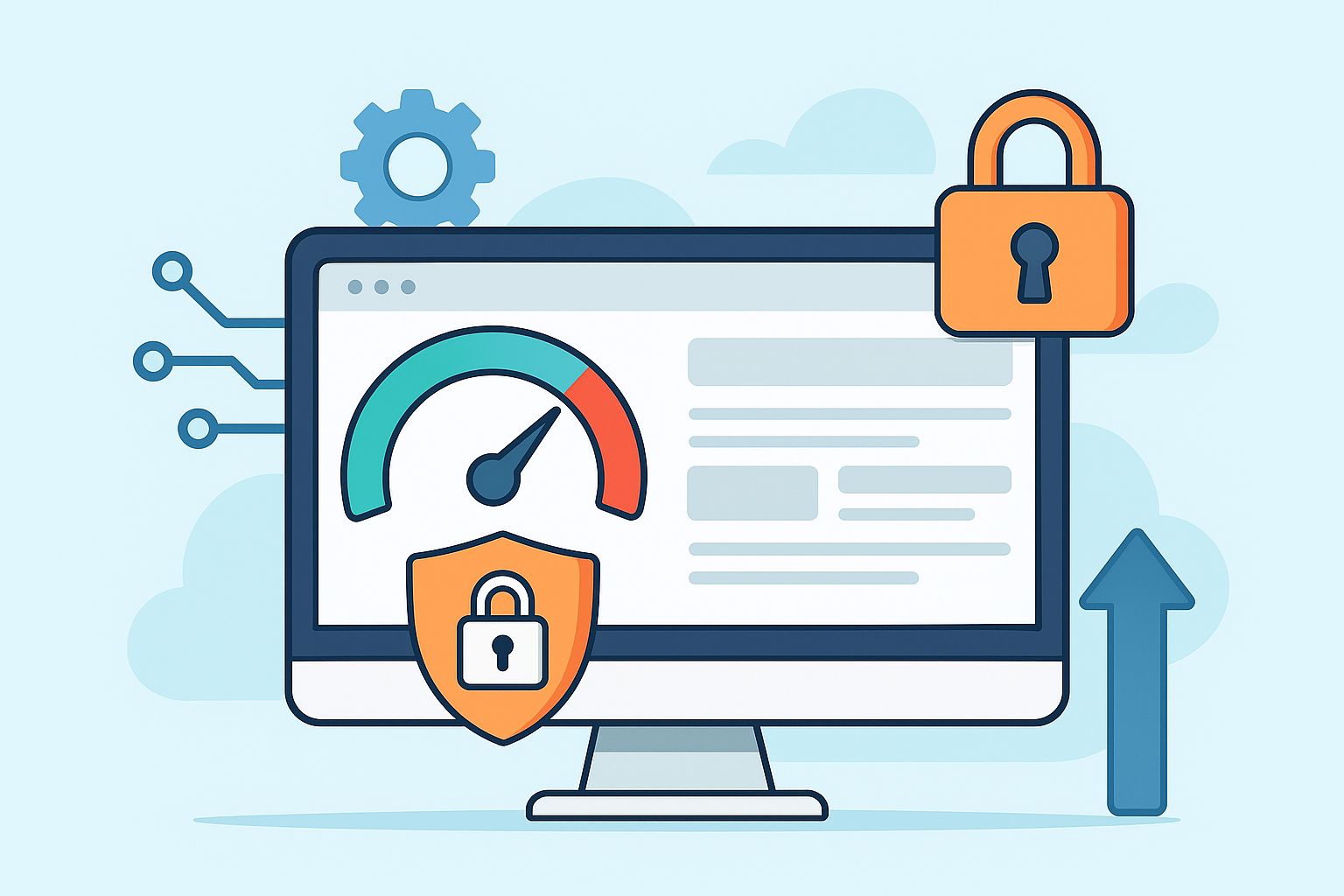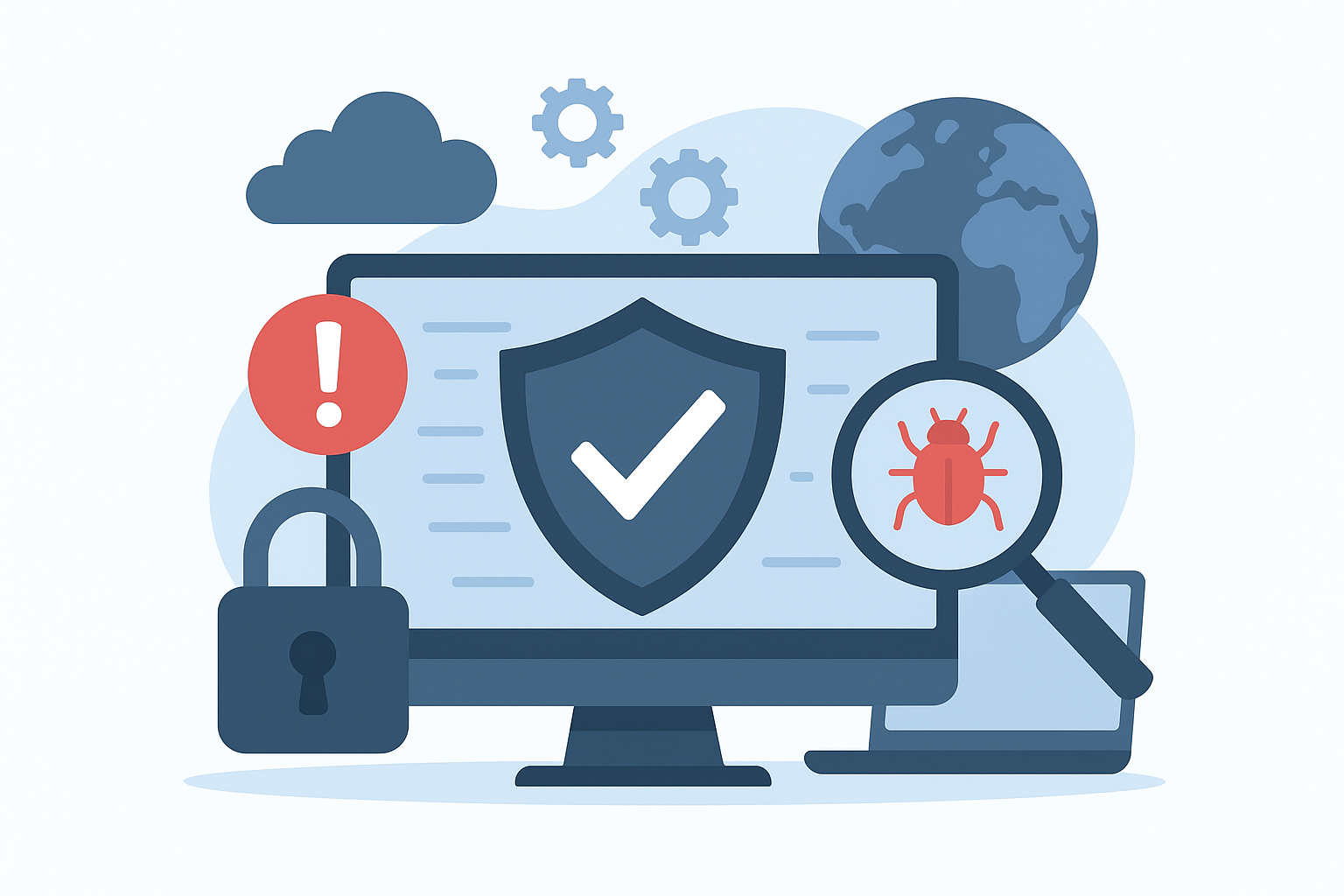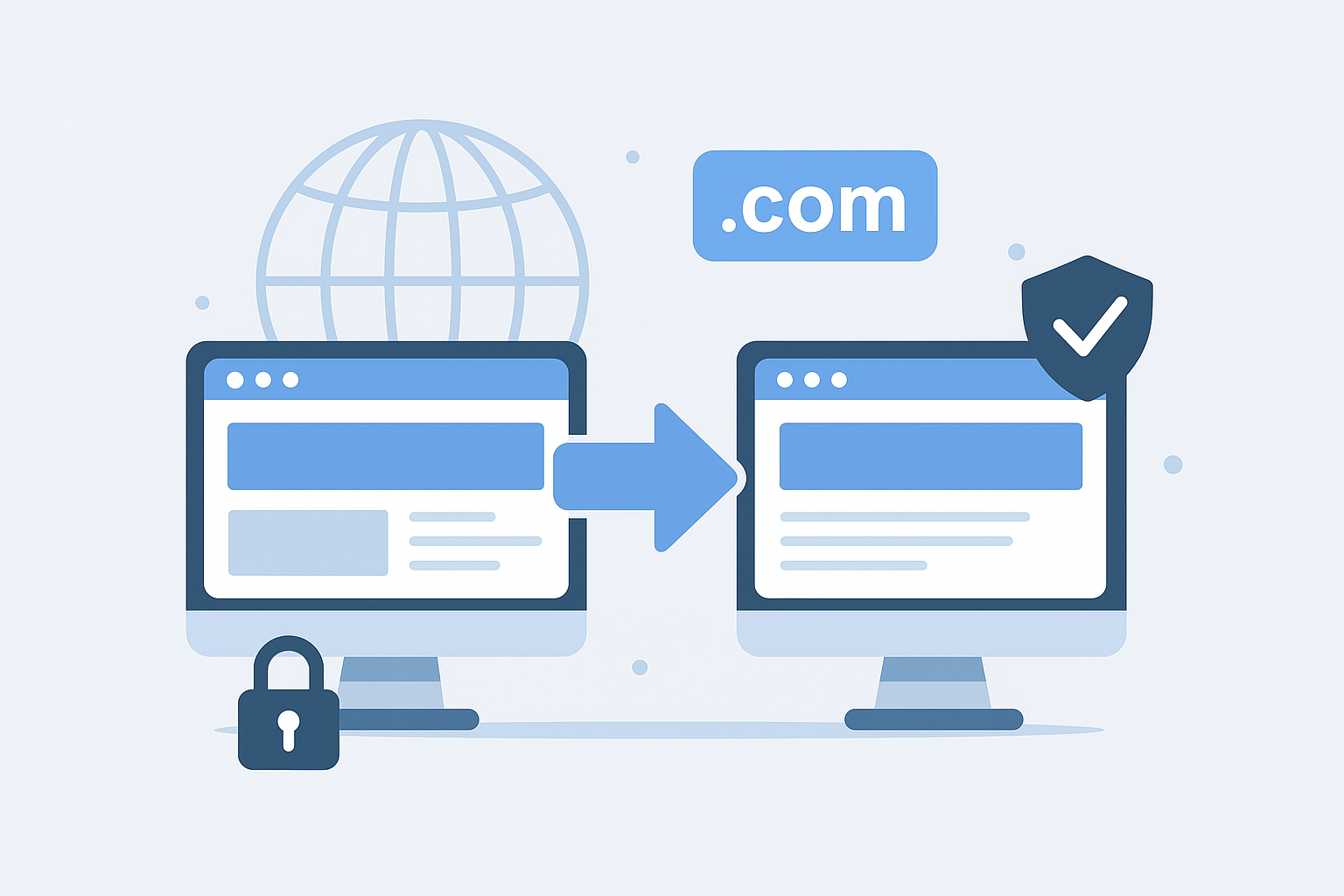Introduction to Website Vulnerability
In today’s interconnected digital world, websites are increasingly vulnerable to cyber threats. Whether you’re running an e-commerce site, a blog, or a business portal, your website holds data that hackers find valuable. A single vulnerability could lead to data theft, loss of SEO rankings, or complete takeover of your site.
That’s why our Free 25-Point Website Vulnerability Check is designed to uncover the most common and damaging security risks — before the hackers do.
Why Regular Vulnerability Checks Matter
Most website owners assume everything is secure once their site is live. Unfortunately, new vulnerabilities emerge daily due to:
- Software/plugin updates
Outdated software, themes, or plugins are among the most common entry points for hackers. Developers frequently release updates to patch known security vulnerabilities, and ignoring these updates can leave your site exposed. Hackers often scan for outdated versions of popular plugins and CMS platforms to exploit them with automated scripts.
- Misconfigured settings
Improper configuration of file permissions, admin privileges, directory access, or firewall rules can leave critical components of your website vulnerable. For example, leaving directories writable by the public or not disabling file editing in WordPress can make it easier for attackers to inject malicious code.
- Weak passwords
Passwords like “admin123” or “password” are incredibly easy for brute-force tools to crack. Weak or reused passwords are a major security risk. If an attacker gains access to a single account, they may be able to escalate privileges or access sensitive data, leading to full-site compromise.
- Server flaws
Web servers with outdated software, insecure open ports, or improper configurations can expose your site to threats. Server vulnerabilities such as remote code execution, directory traversal, or database exposure can provide attackers with full control over your website, especially on shared hosting environments with poor isolation.
Without routine vulnerability assessments, you’re inviting attackers to exploit these weak spots. Our 25-point check ensures your website stays ahead of evolving threats.
Who Needs a Website Vulnerability Check?
This service is vital for:
- Small businesses – who often have limited IT budgets but are frequent targets.
Small businesses often operate on tight budgets and may not prioritize cybersecurity. However, cybercriminals see them as easy targets because they typically lack the infrastructure and resources to implement robust security. One successful breach can lead to massive losses, including customer trust, financial data, and legal trouble.
- E-commerce stores – that handle sensitive payment and user data.
 E-commerce websites store and process highly sensitive data, such as credit card numbers, addresses, and personal details. This makes them prime targets for hackers aiming to steal information or install malicious scripts. A vulnerability check is essential for maintaining PCI compliance and protecting both the store and its customers.
E-commerce websites store and process highly sensitive data, such as credit card numbers, addresses, and personal details. This makes them prime targets for hackers aiming to steal information or install malicious scripts. A vulnerability check is essential for maintaining PCI compliance and protecting both the store and its customers.
- Bloggers/content creators – who rely on SEO and uptime.
For bloggers and influencers, website performance and uptime directly impact revenue, rankings, and audience trust. Even a short downtime due to a vulnerability can hurt SEO and result in lost opportunities. Routine vulnerability scans help ensure consistent availability and protect content integrity.
- Web agencies – managing multiple client websites.
Agencies that manage websites for multiple clients carry a heavier responsibility. A single breach can cascade across several sites, damaging the agency’s reputation. Regular vulnerability checks ensure that client websites remain secure, up-to-date, and compliant with industry best practices.
- Startups – preparing for product launches or fundraising.
Startups often move fast and overlook security in the rush to launch or impress investors. However, any breach during a critical stage (like a product launch or fundraising round) can derail growth and cause trust issues. Early vulnerability assessments help secure the foundation for future scalability and success.
Even personal websites aren’t immune from being infected or blacklisted.
Overview of Our Free 25-Point Website Vulnerability Checklist
Our checklist covers all major security layers, including:
- Application-level vulnerabilities
These refer to security flaws within your website’s software — such as custom code, themes, or third-party plugins. Examples include SQL injection, Cross-Site Scripting (XSS), or insecure APIs. If exploited, attackers can gain unauthorized access to data or user sessions. Detecting and patching these vulnerabilities helps protect the core of your web application.
- Server configuration flaws
Many attacks originate from misconfigured servers — such as open ports, outdated software versions, or exposed directory listings. These flaws can give hackers a backdoor into your system. A server-level scan identifies such issues and offers ways to harden the server environment for better protection.
- User access controls
Weak user permissions and roles can lead to internal data leaks or unauthorized changes to your website. For instance, if all team members have admin-level access, it increases the risk of accidental or malicious modifications. A vulnerability check reviews your access hierarchy to ensure proper role-based access control (RBAC) is in place.
- Malware and blacklist status
Your site could be infected with malware without you knowing — especially if it’s hidden in core files or themes. This may lead to search engine blacklisting, warnings to users, or even email deliverability issues. Vulnerability scans detect such infections and check your site’s status with Google Safe Browsing, McAfee, Norton, and other authorities.
- SSL and encryption protocols
Secure Sockets Layer (SSL) certificates ensure encrypted communication between your server and visitors. A scan reviews your certificate’s validity, strength (e.g., TLS 1.2 vs TLS 1.3), and whether any weak encryption methods are still active. Poor SSL setup can lead to MITM (Man-in-the-Middle) attacks or failed trust signals in browsers.
- CMS/plugin weaknesses
Most websites today rely on content management systems like WordPress, Joomla, or Drupal — and use multiple plugins or extensions. If these are outdated or poorly coded, they become prime targets for hackers. A vulnerability check identifies insecure or deprecated plugins and checks for zero-day vulnerabilities affecting your CMS core.
Let’s break down what we scan in detail.
Detailed Breakdown of the 25 Checks
A. Website & Application Layer
- SQL Injection – Attempts to manipulate your site’s database.
SQL Injection (SQLi) is a powerful attack technique where hackers insert malicious SQL queries into input fields — like login forms or search boxes — to manipulate your website’s database. If successful, it can allow attackers to steal, modify, or delete sensitive data such as usernames, passwords, or financial records. This is one of the most dangerous vulnerabilities and must be prevented using parameterized queries and input validation.
- Cross-Site Scripting (XSS) – Used to inject malicious scripts into pages.
XSS attacks occur when malicious scripts are injected into web pages viewed by other users. These scripts can hijack user sessions, steal cookies, or redirect visitors to fake/phishing pages. For example, a hacker may insert JavaScript into a comment form that executes when another visitor loads that page. Preventing XSS requires sanitizing user input and using content security policies (CSPs).
- Cross-Site Request Forgery (CSRF) – Tricks users into taking actions without consent.
CSRF attacks trick authenticated users into performing unwanted actions — like changing account details or making purchases — without their knowledge. A typical scenario involves a malicious link or form that silently sends a request using the user’s session cookies. Defending against CSRF involves using tokens (CSRF tokens) in forms and double-checking user intent on critical actions.
- File Upload Vulnerabilities – Hackers can upload malicious scripts.
Many websites allow file uploads for forms, resumes, images, etc. If not secured, attackers can upload .php, .exe, or scripted image files that execute malicious code on your server. This can lead to full website takeovers. Protection includes restricting file types, using MIME type validation, and storing uploads outside the root directory.
- Session Hijacking – Attackers steal login sessions.
Session hijacking happens when attackers intercept or steal session tokens (usually stored in cookies) to impersonate a user. If successful, they gain full access to the victim’s account without needing credentials. This threat can be mitigated with HTTPS encryption, secure cookie flags, short session durations, and multi-factor authentication (MFA).
B. Server & Hosting Configuration
- Open Ports Scan – Detects unnecessary and exploitable open ports.
An Open Ports Scan identifies all open ports on your server. Open ports are gateways for communication, but if unnecessary ones are left open (like FTP, SSH, or database ports), they can become entry points for attackers. This scan helps detect unused or misconfigured ports that should be closed or firewalled, reducing your attack surface significantly.
- Directory Listing – Exposes sensitive files if misconfigured.
Directory Listing allows anyone to view the contents of a folder on your website if index files (like index.html or index.php) are missing. This exposes sensitive files such as backups, configurations, or temporary uploads. Disabling directory listing and securing access via .htaccess or server configuration is essential to prevent data leakage.
- Default Credentials – Checks for unchanged admin logins.
This check looks for commonly used or default usernames and passwords like “admin/admin” or “root/root”. Leaving default logins unchanged is a major vulnerability — bots and hackers actively scan for these. A proper security audit enforces strong, unique passwords and multi-factor authentication (MFA) wherever possible.
- SSL Certificate Validation – Confirms HTTPS security.
SSL (Secure Sockets Layer) ensures that data transferred between the browser and server is encrypted. This check confirms:
- If HTTPS is enabled
- If the SSL certificate is valid and not expired
- If strong encryption protocols are in place
A valid SSL certificate builds user trust, improves SEO, and prevents man-in-the-middle attacks.
- Server Banner Disclosure – Prevents version info from being exposed.
Servers often display their software and version in HTTP headers or error messages (e.g., Apache 2.4.18). This is called Server Banner Disclosure, and it provides attackers with valuable information to target known vulnerabilities. This check ensures that these banners are removed or masked, making it harder for hackers to plan their attack.
C. CMS & Plugin Weaknesses
- Outdated CMS Version – Known vulnerabilities in old releases.
Running an outdated Content Management System (CMS) like WordPress, Joomla, or Drupal means you’re exposed to known vulnerabilities. Hackers often exploit old versions using publicly available exploits. Regular updates patch security holes, enhance performance, and keep your website secure against emerging threats.
- Vulnerable Plugins – Popular attack vector through outdated plugins.
Plugins and extensions add functionality but can also introduce security risks, especially if they’re outdated, poorly coded, or no longer maintained. Attackers frequently target popular plugins with known flaws. A vulnerability scan checks for plugin versions and compares them against security advisories to highlight risk areas.
- Inactive Themes – Could hide malicious code.
Even when not in use, inactive themes remain on your server and can serve as hiding spots for malware or backdoors. Hackers may insert malicious scripts into these unused files, knowing they’re rarely checked. It’s best practice to remove all themes you’re not actively using to minimize risk.
- Weak Admin Password – A major entry point for brute-force attacks.
A weak admin password is one of the easiest ways for attackers to gain access. Brute-force tools try thousands of combinations rapidly. Passwords should be long, complex, and unique—ideally stored in a password manager. Enabling two-factor authentication (2FA) adds an additional security layer.
- Misconfigured Permissions – Folder/file access issues.
Incorrect file and folder permissions can grant unauthorized users the ability to read, write, or execute sensitive files. For example:
- 777 permissions (full access to everyone) on a config file is dangerous.
- Admin-only files being publicly accessible is a big red flag.
A proper security scan flags misconfigurations and ensures critical files have restricted access.
D. Malware & Blacklist Status
- Malware Scan – Checks for known viruses, trojans, and spam.
This step involves scanning all files on your website for malware signatures, including viruses, Trojans, spyware, adware, and injected spam links. It compares your site code against known malicious patterns to detect infections that can steal user data, redirect traffic, or harm visitors.
- Blacklist Status – From Google, McAfee, Norton, etc.
Search engines and antivirus services may blacklist your domain if it is found hosting malware or phishing content. This scan checks if your website is flagged by platforms like:
- Google Safe Browsing
- McAfee SiteAdvisor
- Norton Safe Web
Being blacklisted can reduce organic traffic, damage SEO, and lead to warning messages for users visiting your site.
- Suspicious Code Detection – Hidden iframes, base64, obfuscated JavaScript.
Hackers often inject hidden or obfuscated code into websites to avoid detection. This includes:
- Hidden iframes that load malicious sites in the background
- Base64-encoded strings to mask malicious payloads
- Compressed JavaScript that executes dangerous scripts
This scan identifies suspicious code patterns and flags anything non-standard or encrypted.
- Phishing Page Detection – To ensure your domain isn’t used as bait.
Cybercriminals may use compromised websites to host phishing pages that mimic trusted brands (e.g., PayPal, banks) to steal credentials. This scan looks for:
- Pages resembling login portals of other services
- Fake forms or redirect scripts
- Pages linked to known phishing campaigns
Detecting and removing these prevents your domain from being used in scams and keeps your visitors safe.
- Injected Backdoors – Persistent malicious access points.
Backdoors are secret entry points added by hackers to regain access even after removal of malware. They’re usually hidden in:
- Plugin or theme files
- Upload folders
- Custom PHP shells
This scan searches for known backdoor scripts and alert patterns like unauthorized eval(), exec(), base64_decode() functions, helping prevent future compromises.
E. Performance & Security Enhancers
- SSL Redirect Check – Ensures all traffic is forced through HTTPS.
This ensures that all visitors are automatically redirected from HTTP to HTTPS, encrypting communication between the user and your website.
- Protects sensitive data like login credentials or payment info
- Avoids browser security warnings
- Improves SEO ranking as Google prioritizes HTTPS sites
Without this, data can be intercepted or altered by attackers.
- CAPTCHA Validation – Against bots on login/contact forms.
CAPTCHA (Completely Automated Public Turing test to tell Computers and Humans Apart) helps prevent automated bots from:
- Submitting fake contact forms
- Spamming comment sections
- Brute-forcing login credentials
By adding CAPTCHA or reCAPTCHA, you ensure that only humans interact with your site’s sensitive input areas.
- Rate Limiting – Prevents brute-force attacks.
Rate limiting restricts the number of login or request attempts from a single IP address within a given time frame.
- Helps block automated brute-force attacks trying to guess passwords
- Protects against Denial-of-Service (DoS) attempts
- Keeps server load under control and reduces resource abuse
It’s an essential layer of defense especially for login and admin pages.
- Two-Factor Authentication (2FA) – Adds another security layer.
2FA requires users to provide two forms of verification when logging in:
- Something they know (password)
- Something they have (OTP via email/SMS/app)
Even if attackers steal passwords, they can’t log in without the second factor. This significantly reduces the risk of unauthorized access.
- Security Headers Analysis – X-Frame-Options, CSP, HSTS, etc.
Security headers instruct the browser to enforce additional security rules, protecting your website from a range of attacks:
- X-Frame-Options – Prevents clickjacking by disallowing site loading in iframes
- Content Security Policy (CSP) – Blocks unauthorized scripts or content
- HTTP Strict Transport Security (HSTS) – Forces all future traffic to HTTPS
These headers are often overlooked but play a critical role in front-end protection.
How to Run a Vulnerability Check (Step-by-Step)
Performing a thorough audit is easier than you think:
- Enter your URL on our vulnerability scan page.
To begin the process, simply enter your website’s domain (e.g., www.example.com) on our dedicated scan form.
- No need to create an account or share sensitive info
- Works with all types of websites – WordPress, e-commerce, custom CMS
- Fast, free, and secure submission
This step kickstarts the automated 25-point audit within seconds.
- We run automated scripts through all 25 points.
Our backend system uses industry-standard security tools and custom-built scripts to perform a comprehensive scan across:
- Application & server-level vulnerabilities
- CMS/plugin issues
- SSL/HTTPS and encryption settings
- Malware presence and blacklist status
Each of the 25 checks is executed in a non-invasive way, ensuring your site remains unaffected.
- Within minutes, you’ll receive a detailed security report.
After scanning, you’ll receive a comprehensive and easy-to-understand report that includes:
- Vulnerabilities found (if any), categorized by severity
- Suggestions for remediation
- Screenshots or code snippets for critical findings
- Blacklist status with third-party security vendors (Google, Norton, etc.)
The report is formatted for both technical and non-technical readers.
- You can then consult our team for recommended fixes or handle them in-house.
Once you have the report:
- You can schedule a free consultation with our cybersecurity experts
- Or share it with your internal development team to fix issues
- We also offer one-time fixes and ongoing protection plans if you prefer a hands-off approach
This flexible approach empowers you to take control of your website’s security—whether you’re a developer, business owner, or agency.
This no-cost check is available 24/7 for any domain — no strings attached.
Common Issues We Discover (and How We Fix Them)
Some frequent problems uncovered include:
- Exposed wp-config.php file in WordPress
The wp-config.php file contains sensitive data like database credentials, security keys, and configuration settings.
- If improperly secured, hackers can access or download this file directly from the browser.
- Exposure may lead to database compromise, complete site takeover, or injection of malicious code.
- A common vulnerability due to misconfigured file permissions or server settings.
- Admin panel access from public IPs
Leaving your admin dashboard accessible to any IP address increases the attack surface.
- Hackers can launch brute-force login attacks or exploit login flaws.
- Best practice is to restrict admin access to specific IPs or use a VPN/firewall for added protection.
- Monitoring failed login attempts is crucial to detect abuse.
- Outdated plugins with critical flaws
Plugins often contain vulnerabilities that are fixed in newer versions. Using outdated ones is risky.
- Hackers target these to inject malware, redirect users, or gain admin-level access.
- Some older plugins are no longer supported or removed from repositories, making them prime targets.
- Regular updates and audits are essential for plugin hygiene.
- Malware that reinjects itself on cleanup
Some malware is designed to persist or reinfect a site even after cleanup.
- They install backdoors, use cron jobs, or infect core files and databases.
- Manual cleanup without addressing these backdoors often results in repeated infections.
- A thorough scan and file integrity monitoring are necessary for complete removal.
- Suspicious user accounts created without your knowledge
If your website has a registration system or weak user access controls, attackers can create unauthorized accounts.
- These accounts may have elevated privileges and can be used to install malware or alter settings.
- Hidden users can remain unnoticed unless you’re auditing your user list regularly.
- Implementing two-factor authentication and limiting registration options can reduce this risk.
Our team can handle these via one-time malware removal, site hardening, or an ongoing security subscription.
Benefits of Fixing Vulnerabilities Early
Proactive site security provides benefits like:
- SEO protection (Google hates hacked sites)
Search engines like Google penalize websites that have been compromised. If your site is hacked, it may be flagged with a “This site may harm your computer” warning, removed from search results, or experience a sharp drop in rankings. This directly affects your organic traffic and visibility. Securing your website helps maintain SEO integrity, ensuring that your pages continue to rank well and attract potential customers without interruption.
- User trust and professional credibility
 A secure website signals professionalism and reliability to your visitors. If users encounter security warnings, pop-ups, or malware downloads, they’ll quickly lose trust in your brand. Even one breach can cause long-term reputational damage. On the other hand, a secure, clean site builds confidence, increases user engagement, and enhances your overall brand image.
A secure website signals professionalism and reliability to your visitors. If users encounter security warnings, pop-ups, or malware downloads, they’ll quickly lose trust in your brand. Even one breach can cause long-term reputational damage. On the other hand, a secure, clean site builds confidence, increases user engagement, and enhances your overall brand image.
- Data safety for clients and users
Your website often stores or processes sensitive user information, such as email addresses, phone numbers, or even payment details. A compromised site can lead to data breaches, identity theft, or misuse of personal information. Strong security measures protect your clients’ and users’ data, helping you comply with privacy laws (like GDPR) and avoid legal issues.
- Business continuity with zero downtime
Website attacks often lead to downtime, which can disrupt business operations, affect revenue, and frustrate customers. Malware infections may force you to shut down temporarily while the issue is fixed. A properly protected site ensures smooth, uninterrupted service, allowing your business to operate 24/7 without risk of failure due to cyberattacks.
- Cost savings — preventing incidents is cheaper than reacting to them
Proactive website security is far more affordable than dealing with the aftermath of a breach. Emergency malware removal, reputation repair, SEO recovery, and potential legal liabilities can cost thousands of dollars. Investing in preventive security measures saves you money, time, and stress by reducing the chances of needing expensive remediation services later on.
When and How Often Should You Scan?
We recommend:
- Monthly scans for most small businesses
Small business websites that don’t handle sensitive data or high traffic volumes can typically rely on monthly malware scans. These scans help detect vulnerabilities, outdated software, or any suspicious activity before it becomes a serious problem. For blogs, portfolios, and informational sites, a monthly schedule strikes a balance between protection and cost-efficiency, ensuring ongoing safety without unnecessary overhead.
- Weekly scans for e-commerce stores
E-commerce websites process payments, customer information, and inventory — making them a prime target for cybercriminals. Running weekly scans allows businesses to identify and eliminate threats like credit card skimmers, unauthorized code injections, or malicious redirects. This regular check ensures your online store remains secure, compliant with PCI DSS standards, and retains customer trust.
- Daily scans for high-risk, high-traffic sites
Websites with large traffic volumes, high user interaction, or sensitive operations (like banks, healthcare sites, SaaS platforms) require daily security scans. Frequent scanning helps catch threats in real-time, minimizing the damage from potential breaches. These sites are often high-value targets, so a daily routine is critical for ensuring robust protection and maintaining operational continuity.
- After any major change like new themes, plugins, or CMS upgrades
Anytime you make a major update — whether it’s installing a new theme, adding a plugin, or upgrading your content management system (CMS) — it’s important to run an immediate scan. These changes can unintentionally introduce security flaws, conflicts, or even vulnerabilities from third-party code. Scanning right after helps you identify issues early, ensuring your website remains secure after modifications.
Remember: One scan isn’t enough — threats evolve constantly.
Why Choose FixHackedSite for Vulnerability Scans?
We specialize in website security, malware removal, and performance hardening. What makes our check different:
- Truly free with no signup required
Many “free” tools require you to sign up or provide personal details before access, but this scan is completely free and accessible instantly. There’s no need for an account, credit card, or email address. This ensures privacy, ease of use, and transparency, allowing users to check their website’s security status without barriers or hidden costs.
- No technical knowledge needed
This tool is designed for everyone — not just developers or cybersecurity experts. Whether you’re a small business owner, blogger, or marketer, you can easily run the scan and understand the results. The interface is simple, user-friendly, and doesn’t require any coding, server access, or technical background. Anyone can protect their site in just a few clicks.
- Human-verified reports and recommendations
Unlike fully automated scans that may produce false positives or confusing alerts, this check includes manual verification by security professionals. The results are accurate, prioritized, and easy to understand. Each issue is accompanied by clear, actionable recommendations so you know exactly what to fix and how to fix it — no guesswork.
- Backed by cybersecurity professionals
This tool isn’t just built by generic developers — it’s supported by experienced cybersecurity experts who understand real-world threats. The scan is regularly updated to detect emerging vulnerabilities, ensuring your site is tested against the latest attack vectors. You’re getting advice and protection that’s based on industry best practices and hands-on threat research.
- Seamless upgrade options for monthly protection
After your free scan, you can easily upgrade to a premium protection plan if needed — offering features like automated scanning, real-time alerts, malware removal, and firewall integration. This allows businesses to scale their security over time, starting from a free scan and moving to ongoing protection without complicated transitions or technical roadblocks.
Our scan gives actionable insights, not just jargon.
Next Steps: Secure Your Site Now
If you’ve never run a security audit, now is the time. Use our Free 25-Point Website Vulnerability Check today and get peace of mind knowing you’ve taken the first step toward a safer, faster, and cleaner site.
Don’t wait for your website to be hacked — test it now for free!



